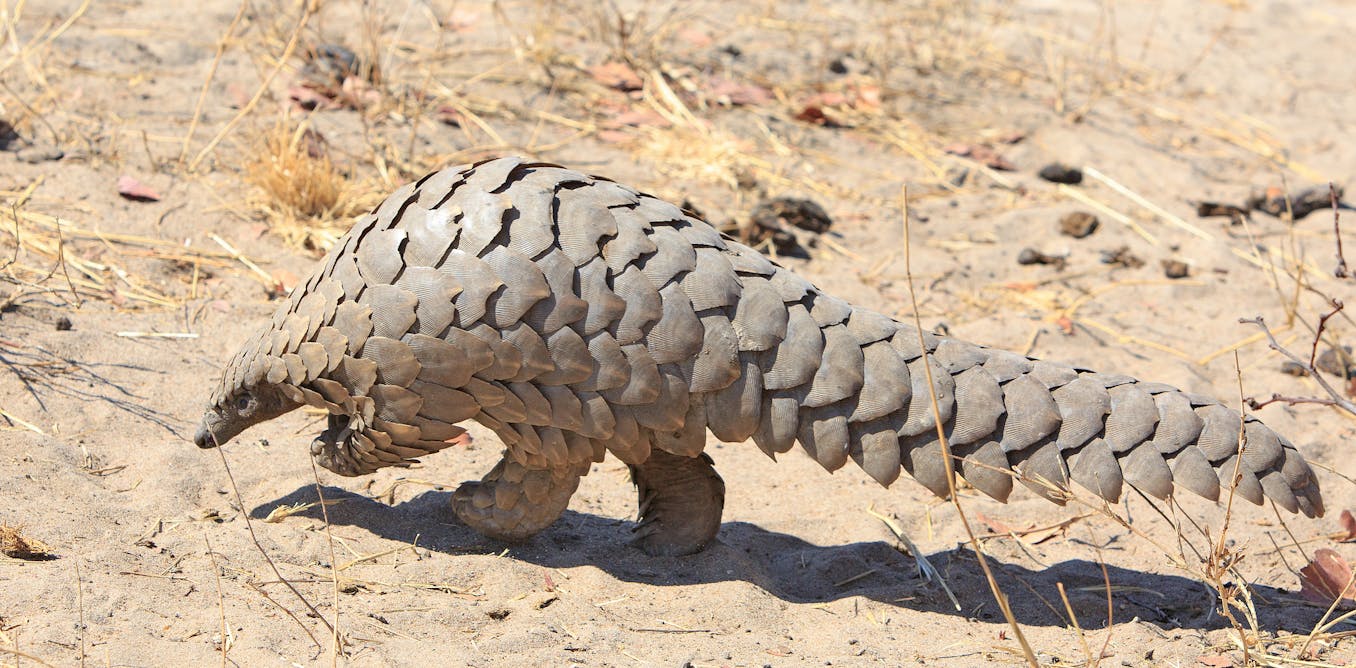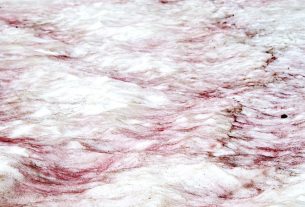A team of scientists who study vertebrate fossil tracks and traces on South Africa’s southern Cape coast have identified the world’s first fossil pangolin trackway, with the help of Indigenous Master Trackers from Namibia. Ichnologists Charles Helm, Clive Thompson and Jan De Vynck tell the story.
What did you find?
A fossil trackway east of Still Bay in South Africa’s Western Cape province was found in 2018 by a colleague and was brought to our attention. It was found on the surface of a loose block of aeolianite rock (formed from hardened sand) that had come to rest near the high-tide mark in a private nature reserve.
We studied it but our cautious approach required that we could not confidently pin down what had made the track. It remained enigmatic.
How did you eventually identify it?
In 2023, we were working with two Ju/’hoansi San colleagues from north-eastern Namibia, #oma Daqm and /uce Nǂamce, who have been interpreting tracks in the Kalahari all their lives. They are certified as Indigenous Master Trackers and we consider them to be among the finest trackers in the world today. We’d called on their expertise to help us understand more about the fossil tracks on the Cape south coast. One example of the insights they provided was of hyena tracks, and we have published on this together.
Read more:
First fossil hyena tracks found in South Africa – how expert animal trackers helped
We showed them the intriguing trackway, which consisted of eight tracks and two scuff marks made, apparently, by the animal’s tail. They examined the track-bearing surface at length, conversed with one another for some time, and then made their pronouncement: the trackway had been registered by a pangolin.
This was an astonishing claim, as no fossilised pangolin tracks had previously been recorded anywhere in the world.
It also confirms that pangolins were once distributed across a larger range than they are now.
We then created three-dimensional digital models of the trackway, using a technique called photogrammetry.
We shared these images with other tracking and pangolin experts in southern Africa (like CyberTracker, Tracker Academy, the African Pangolin Working Group, wildlife guides and a pangolin researcher at the Tswalu Foundation). There were no dissenting voices: not surprisingly, it was agreed that our San colleagues were highly likely correct in their interpretation.
There is something really special about a fossil trackway, compared with fossil bones – it seems alive, as if the animal could have registered the tracks yesterday, rather than so long ago.
What are the characteristics of pangolin tracks?
Pangolins are mostly bipedal (walking on two legs), with a distinctive, relatively ponderous gait. Track size and shape, the distance between the tracks, and the width of the trackway all provide useful clues, as do the tail scuff marks and the absence of obvious digit impressions. A pangolin hindfoot track, in the words of our Master Tracker colleagues, looks as if “a round stick had been poked into the ground”. And being slightly wider at the front end, it has a slightly triangular shape.
Our Master Tracker colleagues are familiar with the tracks of Temminck’s pangolin (Smutsia temminckii) in the Kalahari, which was the probable species that registered the tracks that are now evident in stone on the Cape coast. Other trackmaker candidates, such as a serval with its slim straddle, were considered, but could be excluded or regarded as far less likely.
How old is the fossil track and how do you know?
The surface would have consisted of loose dune sand when the pangolin walked on it. Now it’s cemented into rock. We work with a colleague, Andrew Carr, at the University of Leicester in the UK. He uses a technique known as optically stimulated luminescence to obtain the age of rocks in the area.
The results he provided for the region suggest that these tracks were made between 90,000 and 140,000 years ago, during the “Ice Ages”. For much of this time the coastline might have been as much as 100km south of its present location.
What’s important about this find?
Firstly, this demonstrates what you can uncover when you bring together different kinds of knowledge: our western scientific approach combined with the remarkable skill sets of the Master Trackers, which have been inculcated in them from a very young age.
Without them, the trackway would have remained enigmatic, and would have deteriorated in quality due to erosion without the trackmaker ever being identified.
Read more:
Fossil treasure chest: how to preserve the geoheritage of South Africa’s Cape coast
Secondly, we hope it brings attention to the plight of the pangolin in modern times. There are eight extant pangolin species in the world today, and all are considered to be threatened with extinction. Pangolin meat is regarded as a delicacy, pangolin scales are used in traditional medicines, and pangolins are among the most trafficked wild animals on earth. Large numbers in Africa are hunted for their meat every year.
What does the future hold?
Our San Indigenous Master Tracker colleagues have just completed their third visit to the southern Cape coast, thanks to funding from the Discovery Wilderness Trust.
The results have once again been both unexpected and stupendous, and their tracking skills have again been demonstrated to be unparalleled. Many more publications will undoubtedly ensue, bringing their expertise to the attention of the wider scientific community and anyone interested in our fossil heritage or in ancient hunter-gatherer traditions.
We hope that our partnership continues to lead to our mutual benefit as we probe the secrets of the Pleistocene epoch by following the spoor of ancient animals.
![]()
Clive Thompson is a trustee of the Discovery Wilderness Trust, a non-profit organization that supports environmental conservation and the fostering of tracking skills.
Charles Helm and Jan Carlo De Vynck do not work for, consult, own shares in or receive funding from any company or organisation that would benefit from this article, and have disclosed no relevant affiliations beyond their academic appointment.



